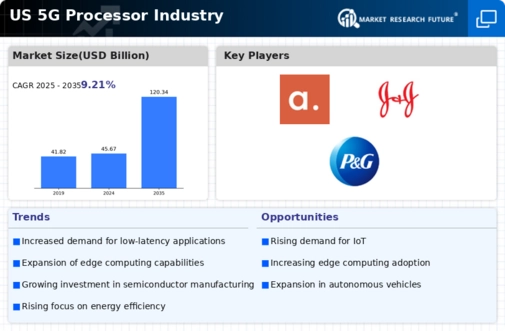Expansion of Smart Cities
The development of smart cities in the US is driving the 5g processor market. These urban areas leverage advanced technologies to improve infrastructure, transportation, and public services. The integration of 5g technology is crucial for real-time data processing and communication. By 2025, investments in smart city initiatives are projected to exceed $100 billion, creating a substantial demand for 5g processors. The 5g processor market is likely to benefit from this trend as municipalities seek to implement solutions that enhance connectivity and operational efficiency.
Surge in IoT Device Adoption
The proliferation of Internet of Things (IoT) devices is a key driver for the 5g processor market. As more devices become interconnected, the demand for high-speed processing capabilities increases. In the US, it is estimated that the number of IoT devices will reach 30 billion by 2025, necessitating advanced 5g processors to handle the data traffic. This surge in IoT adoption is expected to contribute to a market growth rate of approximately 25% annually. The 5g processor market must adapt to these demands by developing processors that can efficiently manage the increased data flow and connectivity requirements.
Growth in Autonomous Vehicles
The rise of autonomous vehicles is significantly impacting the 5g processor market. These vehicles require robust processing capabilities to analyze vast amounts of data from sensors and cameras in real-time. The US automotive industry is investing heavily in 5g technology, with projections indicating that the market for connected and autonomous vehicles could reach $200 billion by 2025. This growth presents a substantial opportunity for the 5g processor market to innovate and provide processors that meet the stringent requirements of safety and performance in autonomous driving.
Increased Mobile Gaming Popularity
The mobile gaming sector is experiencing unprecedented growth, which is positively influencing the 5g processor market. With the advent of 5g technology, mobile gaming can offer enhanced graphics, lower latency, and improved user experiences. The US mobile gaming market is expected to surpass $40 billion by 2025, creating a demand for high-performance 5g processors capable of supporting these advanced gaming applications. The 5g processor market must focus on developing specialized processors that cater to the unique needs of mobile gamers, ensuring seamless and immersive experiences.
Rising Demand for Enhanced Security Features
As cybersecurity threats become more sophisticated, the demand for enhanced security features in processors is increasing. The 5g processor market is responding to this need by integrating advanced security protocols directly into processor designs. In the US, the cybersecurity market is projected to grow to $300 billion by 2025, indicating a strong correlation with the 5g processor market. The 5g processor market is likely to prioritize security innovations to protect sensitive data transmitted over 5g networks, thereby addressing consumer concerns and regulatory requirements.













Leave a Comment